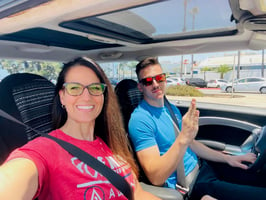Know Yourself Or Keep Losing People.
Why self-awareness isn’t optional in leadership, it’s the whole game.
You can’t lead what you can’t see.
We talk a lot about leadership in the context of skills: strategy, delegation, communication, and goal-setting. But underneath every thriving team, successful company, or healthy relationship, there’s one critical factor most people overlook: self-awareness.
If you don’t know how you show up, how can you expect anyone to follow you? Leadership doesn’t start with a vision. It starts with a mirror.
It’s one thing to call yourself a leader. It’s another to consistently earn the trust of your team, create safe spaces for others to thrive, and carry the weight of decision-making without projecting it onto everyone around you. The most dangerous leaders aren’t malicious. They’re unaware. Unaware of their tone, their patterns, their blind spots. Unaware of how people feel in their presence. And unaware that, over time, these things compound.
Most leadership failures don’t happen in a single moment. They happen over time—because people feel unseen, misunderstood, or unvalued. And the longer you ignore yourself, the more disconnected you become from others.
You’re not difficult. You’re just not decoded.
At Rewired Dynamics, we use tools like the 5 Voices to help individuals and teams uncover their leadership wiring. This isn’t personality typing for the sake of it. This is about understanding your leadership language, and how it affects the people around you.
Everyone has a foundational voice. Pioneers are visionaries. Nurturers are protectors. Guardians are stewards of process. Connectors are bridges. Creatives are pattern disruptors. Each voice brings something powerful. But each voice, when misused or unconscious, also casts a shadow.
Your strength becomes your shadow when it’s unconscious.
-
Pioneers can bulldoze.
-
Nurturers can self-abandon.
-
Guardians can control.
-
Connectors can avoid.
-
Creatives can withdraw.
When you learn your voice and your shadow, you begin to lead on purpose. You stop unintentionally hurting the people you’re trying to help. You start noticing the relational ripples of your choices. And you get the chance to adjust before disconnection becomes the norm.
Relational intelligence isn’t a buzzword. It’s a leadership threshold.
Daniel Goleman’s research shows that emotional/relational intelligence accounts for nearly 90% of what sets high performers apart from their peers. That includes:
-
Self-awareness
-
Self-regulation
-
Motivation
-
Empathy
-
Social skills
But here’s the thing: we still train strategy before we train self. We emphasize performance before presence. We rush toward results without ever pausing to ask, “How am I doing? And how am I making others feel?”
Relational intelligence builds on emotional intelligence. It’s the difference between feeling something internally and knowing how to name it externally. It’s the difference between understanding yourself and knowing how to use that understanding to build trust, deepen relationships, and create clarity.
Without understanding, people withdraw.
When people feel misunderstood, misread, or micromanaged, they disconnect.
Disconnection rarely begins with conflict. It begins with misunderstanding. That team member who suddenly disengaged? That partner who always seems “busy”? That friend who stopped calling?
More often than not, they didn’t leave because of something you said. They left because of something you didn’t see.
Understanding yourself allows you to spot misalignment before it turns into resentment. It gives you language to name the tension and tools to resolve it. And it gives you access to something we all crave: the ability to be fully ourselves, and fully in connection, at the same time.
Leadership starts with language.
One of the biggest unlocks in our work is giving people a shared language. Whether it’s using the 5 Voices to de-escalate conflict, learning to spot stress behavior before burnout, or simply understanding how someone receives feedback, language bridges the gap.
When we give people the tools to name what’s really going on, we move from assumption to awareness. From confusion to clarity. From performance to presence.
That’s what creates healthy teams. That’s what creates strong families. That’s what builds connected communities.
So ask yourself:
-
Do you know what it’s like to be on the other side of you?
-
Do you know how your team feels after you leave the room?
-
Do you know what people stop saying when you show up?
Because if you’re unaware—you’re undercutting your own influence.
The invitation:
If you want to lead people—your team, your family, your community—you have to start with yourself. Because people can feel when you’re disconnected. They can sense when something is off. And they don’t trust what isn’t grounded.
The best leaders we know are the most self-aware. They’ve done the work. They know their voice. They’ve named their patterns. And they’re not afraid to be wrong, because their ego doesn’t drive the car anymore.
So here’s your invitation:
Start with the 5 Voices Assessment. Join a leadership experience like Forge. Ask your team, “What’s it like to be on the other side of me?”
Then listen. Reflect. Rewire.
Because the kind of leader the world needs right now—starts with knowing who you are.
→ Start with the 5 Voices
→ Explore Forge (50% off for the remainder of June)
Let’s stop managing.
Let’s start leading.



